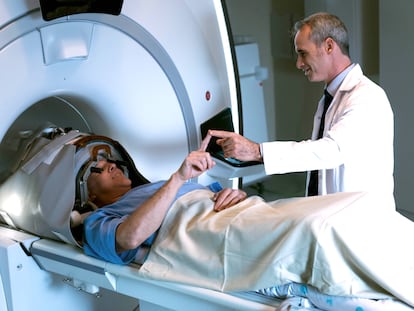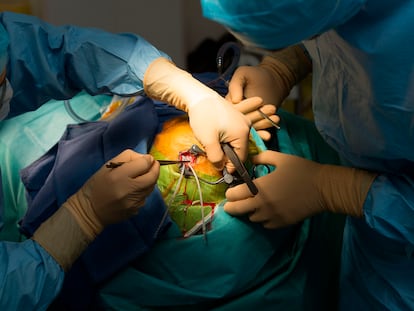A person who has had Parkinson’s disease for 25 years can now walk again thanks to a neuroprosthesis
Researchers directly stimulated the spinal cord, making it possible for the patient to avoid falls and freezing when walking

When he was 36 years old, Marc Gauthier, a citizen of Bordeaux (France), began to experience movement and coordination problems, as well as tremors and stiffness. He was diagnosed with Parkinson’s disease at a very young age. At the beginning of the century, he underwent a double brain implant. He was fitted with a dopamine generator, a key neurotransmitter in organizing movement, and at the same time, a deep brain stimulator (DBS) was implanted in the basal ganglia, the part of the brain that should naturally produce dopamine. But, after some improvement, the falls returned and even worsened, as did the inability to get up, and he experienced continuous motor blocks while walking. Everyday situations such as climbing the stairs were an ordeal; after a few shaky first steps, he ended up turning around. But last Sunday he went for coffee with Eduardo Martín Moraud, a Spanish scientist who forms part of the team that implanted a new neuroprosthesis in him two years ago. “He walked normally and had no trouble getting on the subway,” says Martín. In Gauthier’s own words, “I’m not even afraid of stairs anymore.”
Martín has been working with Grégoire Courtine, a professor at the Swiss Federal Institute of Technology in Lausanne, Switzerland, since the professor directed Martín’s doctorate. For years, Martín, Courtine and neurosurgeon Jocelyne Bloch, of the university hospital in the same city, have been researching how to help paraplegics walk again. In this long-term research, they first experimented on rats. After achieving the closest thing to a miracle, they tested their way of bypassing spinal cord lesions that short-circuited communication between the legs and the brain in monkeys. Having validated their approach in an animal model, they began testing it on humans, with positive results in 2018. Last year, they succeeded in getting three paraplegics to regain their ability to walk the day after surgery. “In the grant that Courtine applied for in 2009, he mentioned that this system could also be applied to people who had Parkinson’s,” recalls Martín. And the scientists have done just that with Gauthier.
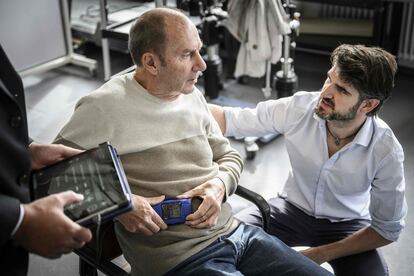
This team of scientists — which includes some fifteen neuroscientists, neurosurgeons, physicians, nurses and rehabilitation specialist s— just published the results of their work in the scientific journal Nature Medicine. It may seem strange that, after years of research on paraplegics, the team recruited a Parkinson’s disease patient like Gauthier. At first glance, a neurodegenerative disease that occurs deep in the brain has little to do with paraplegia caused by an accident that has shattered a young man’s spinal cord. But “regardless of the origin of the problem, all control of the legs goes through the spinal cord. In one case, no information reaches the brain because it has been severed; in the other, information does reach the brain, but it is anomalous,” Martín explains.
In the lower back, in the medulla portion of the lumbar and sacral regions of the spine, there is a set of motor neurons that are responsible for ordering the leg muscles to activate. They also receive information from the legs about their state of movement or rest and then send that information to the medulla. That is where they are acting now; in a way, they are forgetting about Parkinson’s disease. Through this kind of deception of the brain, epidural stimulation has succeeded in correcting the erroneous information coming from the cerebral motor cortex.
“I’m not even afraid of stairs anymore.”Marc Gauthier, a Parkinson's disease patient for the past 25 years
Two years ago, when Gauthier arrived at NeuroRestore’s headquarters, the facility where Martín works and of which both Courtine and Bloch are co-directors, his locomotor system was in serious trouble. Often, when he tried to get out of his chair, his legs did not respond. When he was able to get out of the chair, he fell five or six times a day and could not walk a few feet without being forced to freeze to a halt. In videos shared by the scientists, there are two heart-wrenching scenes. In one, a caregiver helps a trembling Gauthier up a flight of stairs. After only three or four steps, he stops and has to turn around and give up. Another episode would seem comical, if it were not so heartbreaking. Taking short and fearful steps, Gauthier reaches the door of an elevator. He waits for it to open and when it does, he is unable to enter, he cannot move, and the door closes again. This happens several times.
After the implant, the patient spent six months in Switzerland, testing the whole system and participating in an intensive rehabilitation program. He had to recover abilities that he began to lose a quarter of a century ago. Since returning to Bordeaux, Gauthier has gone on several trips, can walk 5 kilometers (3 miles) without major difficulties and, as he told Martín last Sunday, he felt very well and many of his fears had been assuaged. In a second series of videos from after the implant and rehabilitation, Gauthier can get out of his chair, climb the stairs on his own and get into an elevator.
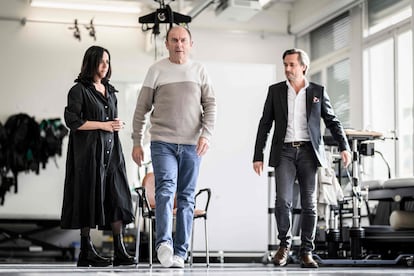
“It is impressive to see that by electrically stimulating the spinal cord selectively, as we had done with paraplegic patients, we can correct gait disorders caused by Parkinson’s disease,” explains Bloch, the neurosurgeon who performed the implant operation on Gauthier. Every six months, Gauthier returns to Switzerland for a check-up. He uses the neuroprosthesis for over eight hours a day and only turns it off when he plans to sit for a while or when he goes to sleep and turns it on again when he wakes up.
To achieve the happy ending in Gauthier’s story, the scientists first had to fine-tune their idea. They had a lot of accumulated knowledge from over a decade of research on paraplegics. But Parkinson’s disease is quite different. The researchers had to learn which area to stimulate with the electrodes, figure out how intense that stimulation should be and determine what was happening in the motor cortex to find a relationship between muscle movement and brain activation. They were not starting from scratch, but there were many unknowns. First, they tested the system with nine rhesus macaques: the scientists administered a compound to induce a disorder with symptoms similar to those in Parkinson’s, then studied the animals’ kinetics and compared the results to those of 25 Parkinson’s patients and nine healthy people. With that information, they then implanted the electrode arrays in four of the monkeys and began modulating the signal, measuring limb response and its correlate in brain activity. They found that the system decoded the brain instructions well. Then it was Gauthier’s turn.
“It’s only one participant, and we don’t know if all individuals with Parkinson’s disease will respond to the therapy.”Professor Grégoire Courtine of the Federal Polytechnic School of Lausanne
Gauthier has already returned to Bordeaux with his implant. The electrode array is used to mitigate chronic pain in certain patients. Now, a Swiss company, ONWARD Medical, is designing specific ones to place in Parkinson’s patients. At the same time, Courtine’s team has received a grant of $1 million from the Michael J. Fox Foundation for Parkinson’s Research for the next phase of the project: placing the implant in six more people. In an interview released by his university, Courtine explains that, right now, “it’s only one participant, and we don’t know if all individuals with Parkinson’s disease will respond to the therapy. But we are committed to developing a technology with the real purpose of [achieving] medical advances specifically for this disease.”
As Martín notes, “[Parkinson’s] is a highly variable disease, which changes over time in the same patient and develops differently in different people.” In fact, it is so heterogeneous that some do not develop motor problems until a very advanced stage, while others’ have their gait altered from the beginning. That’s why researchers need to test the implant in as many people as possible. In January, the six candidates for the second phase will be selected. If that goes well, there will be a third stage. “We hope that [will happen] in several hospitals and countries,” Martín says. These trials are necessary before this device can be manufactured on a large scale to offer hope to the thousands of people affected by Parkinson’s disease.
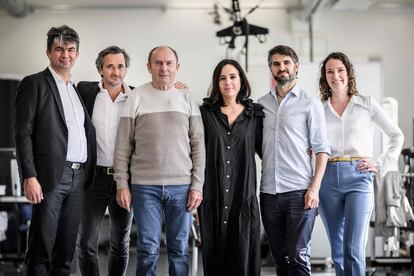
Sign up for our weekly newsletter to get more English-language news coverage from EL PAÍS USA Edition

